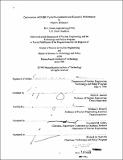Optimization of DUPIC cycle environmental and economic performance
Author(s)
Bollmann, Chad A. (Chad Arnold), 1974-
DownloadFull printable version (7.320Mb)
Alternative title
Optimization of direct use of spent pressureized water reactor fuel in the Canadian Deuterium Reactor cycle environmental and economic performance
Advisor
Mujid S. Kazimi and Michael J. Driscoll.
Terms of use
Metadata
Show full item recordAbstract
A study of the DUPIC (Direct Use of Spent PWR Fuel In CANDU) cycle was made to analyze cycle performance relative to that of PWR and CANDU fuel cycles in terms of uranium utilization and spent fuel production efficiency. The DUPIC cycle was found to be most efficient in terms of minimizing spent fuel production as well as most efficient (within limits) in terms of maximizing natural uranium utilization. It was found minimally productive to change PWR fuel management practices in order to extend burnup in the CANDU portion of the cycle. A policy analysis regarding potential implementation of the DUPIC cycle in North America, between the U.S. and Canada, was also made. CASMO computer models of PWR, CANDU, and CANFLEX fuel assemblies were created and benchmarked. The PWR models were then used to develop analytical correlations that predict PWR spent fuel isotopic compositions. Correlations that predict reactivity gain and burnup increase in CANDU reactors due to AIROX processing of PWR spent fuel were created. An estimate of fission product removal fractions during AIROX processing was developed. An integrated model that predicts CANDU discharge burnup extension due to the use of spent PWR fuel and AIROX processing was completed and used to analyze and compare the DUPIC cycle to other fuel cycles. The potential issues involved in implementation of a DUPIC cycle between the U.S. and Canada were examined. Stakeholders and influential groups were identified and their values were projected. A significant unresolved issue centers around which nation assumes custody of the DUPIC spent fuel and the disposal costs of that fuel. A plan for DUPIC cycle implementation was developed.
Description
Thesis (S.M.)--Massachusetts Institute of Technology, Dept. of Nuclear Engineering; and, (S.M.)--Massachusetts Institute of Technology, Sloan School of Management, 1998. Includes bibliographical references (leaves 109-111).
Date issued
1998Department
Massachusetts Institute of Technology. Department of Nuclear Science and Engineering; Sloan School of ManagementPublisher
Massachusetts Institute of Technology
Keywords
Nuclear Engineering, Sloan School of Management